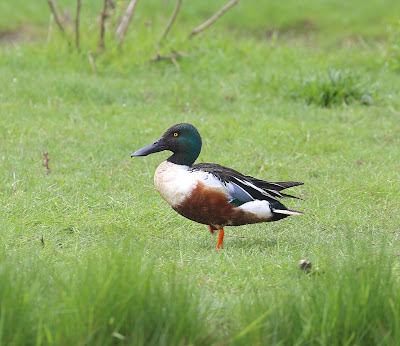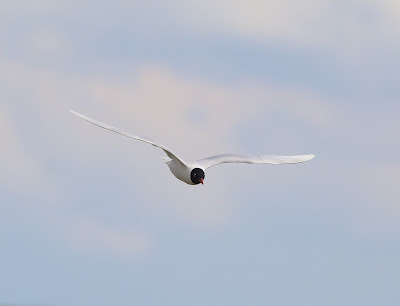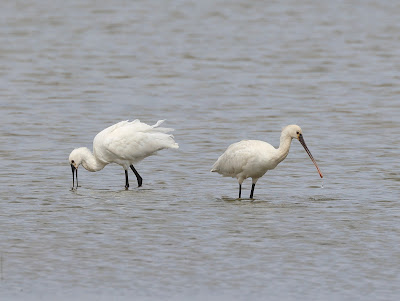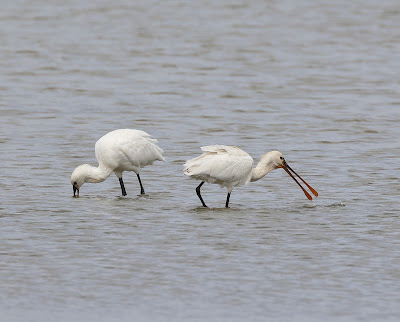For a while, myself, Gareth B & Dan W had planned to gather for a long weekend towards the end of May - hoping the weather would play ball and deliver something, wherever we decided to go!
Dan could longer make it, after which Gareth and I agreed we'd give it til earlier in the week, then hatch a plan and hopefully sort some last-minute accommodation. With easterlies and rain due, the east coast was beckoning and accommodation was swiftly sorted near Downham Market, providing easy journeys to the north Norfolk coast or Lincolnshire.
We set off after work on Friday 24/05. Having grabbed a McDs on route we had enough time for a shortish stoppage on route. We settled on Fen Drayton GPs, east of Huntingdon, with a recent Red-Footed Falcon a possibility. It was a lovely warm, still evening and while the Redfoot didn't appear, it was really pleasant enjoying the sounds of booming Bittern, several Cuckoo (including a Hepatic female) and brilliant views of c5 Hobby hunting beyond dusk.
The next day's forecast was decidedly damp, however it did have the potential for rares and with any luck, the rain would take the form of drizzle, rather than heavy rain! Given the time of year, Blakeney Point was the standout choice, where we would meet up with birding pal Kieran N, for a yomp up that shingle nemisis!
We set off from Cley Coastguards in light drizzle and were soon encountering a number of fly-by Little Terns, Sandwich Terns, Avocets, Oystercatchers, 1 Spoonbill, 1 Greenshank, 1 Brent Goose and a flock of c15 Ringed Plover.
At this end of spring, it will usually be quality over quantity, although having checked most of the key areas, it appeared that it certainly hadn't kicked off yet, with the usual resident Meadow Pipits, a Whitethroat and a Stonechat all to show for our efforts. However with the plantation and surroundings still to check, there was always hope!
Approaching this area, we got the news that a male Red-backed Shrike was just ahead of us at the loopins, by the old lifeboat station - great news, but a shame we didn't get there first!
Before going over for a look, we checked the plantation, picking out a Chiffchaff and a brief, possible Spotted Flycatcher. A couple of Wheatear were also nearby. I wandered over to the shrike area and after a 15 minute or so wait, it popped up on some brambles, allowing the chance to enjoy my first male Red-backed Shrike for a good 7 years and actually, my first UK male!
By this point, the rain had really set in and was becoming pretty bloody horrible to be honest! The shrike went for a short wander about and actually popped up in the plantation for a bit, where 2 Spot Flys were confirmed, showing nicely.
We took a wander over the ridge, finding nothing new, before deciding to get some restbite in the toilet block for a while, optimistically hoping the rain would at least ease a bit. Having watched a chunk of the FA Cup final on my phone, we decided we just had to accept the conditions weren't going to improve and so we began the trudge back to Cley coastguards!
We still kept up our efforts to find more birds, knowing full well we were still in with a chance of something. Thankfully, we were rewarded with another male Red-backed Shrike three quarters of the way back to the car. It was a very tired, begraggled bird, which struggled it's way around the sueda and shingle, where we soon left it to feed up and recover from it's arduous journey. Other birds noted on the way back were singles of both Lesser Whitethroat and Golden Plover.
We were insanely wet through, but luckily my camera was all good. As often the case with visits to the point, a lot of effort for not very much, however it was a good crack and the shrikes were super cool, along with some lovely views of the Little Terns. The shower and dry clothes on our return to the Air Bnb, was welcome to say the least, as was the tandori mixed grill at the local curryhouse - particularly for Gareth who'd left his lunch in the car that morning!
Before heading home on Sunday 26/05, Gareth and I intended to get stuck in to a bit more birding. With not a lot going on in Norfolk, we decided to give Frampton Marsh a go with a few bits a bobs about.
With the threat of rain showers ever present, we took a walk out towards the Marsh Farm reservoir end, to see if we could find the Lesser Yellowlegs and Black-winged Stilt which had both been around for sometime. It didn't take too long to find the Black-winged Stilt which showed nicely on the fen area. A Med Gull was up high fly-catching, while the fen held a small group of Black-Tailed Godwits, plus local breeders Redshank, Lapwing and Avocet.
We moved back to the visitor centre and onto the two nearest hides. Here along with a couple of Spoonbills, we enjoyed some brilliant views of x12 2cy Little Gulls from the Reedbed hide, feeding hyperactively over the water, absolutely relentlessly!
Bearded Tits were on show here, both a male going backwards and forwards in front of the hide, plus some confiding juveniles in the reeds closeby.
The main focus from the 360 hide was the raucous cacophony of the Black-headed Gull colony, however did also provide views of a summering Whooper Swan, the odd adult Med Gull flypast and more breeding Avocets.
It was nearly time to head for home, however not before taking in views of the two feeding Spoonbills at fairly close quarters.
We had another scan for the Yellowlegs but no luck. Having somehow dodged the rain, but with a big storm looming on the horizon we decided to head home. The weather was shite, but some enjoyable birding was had!


































































